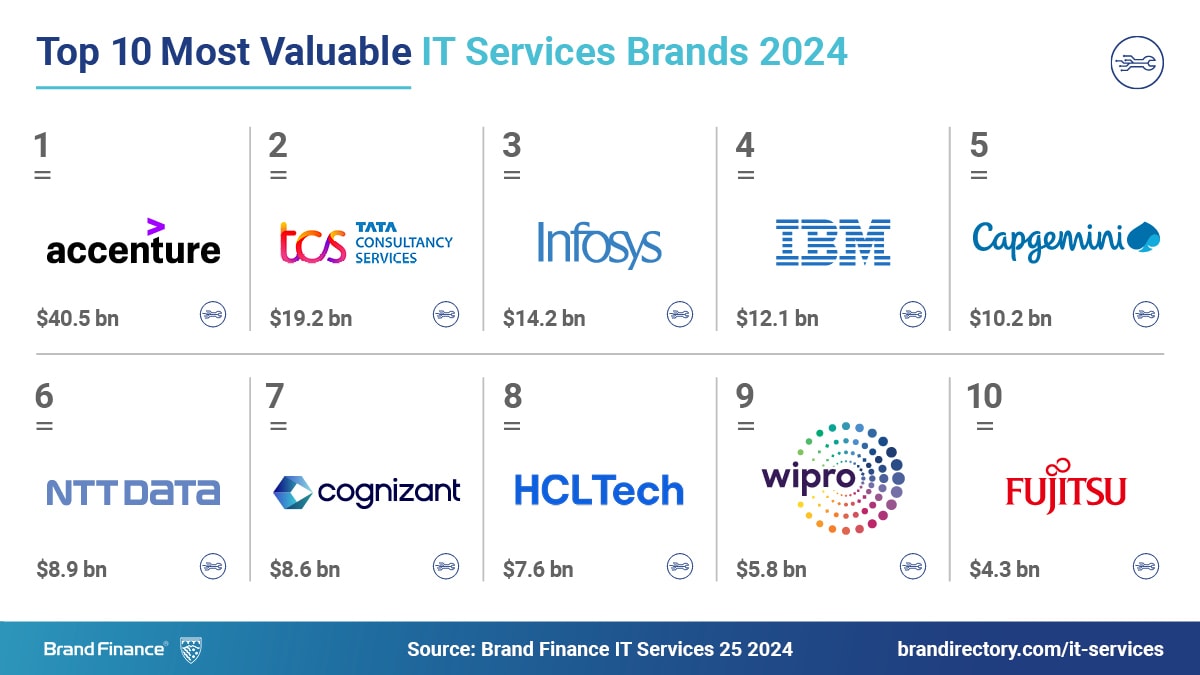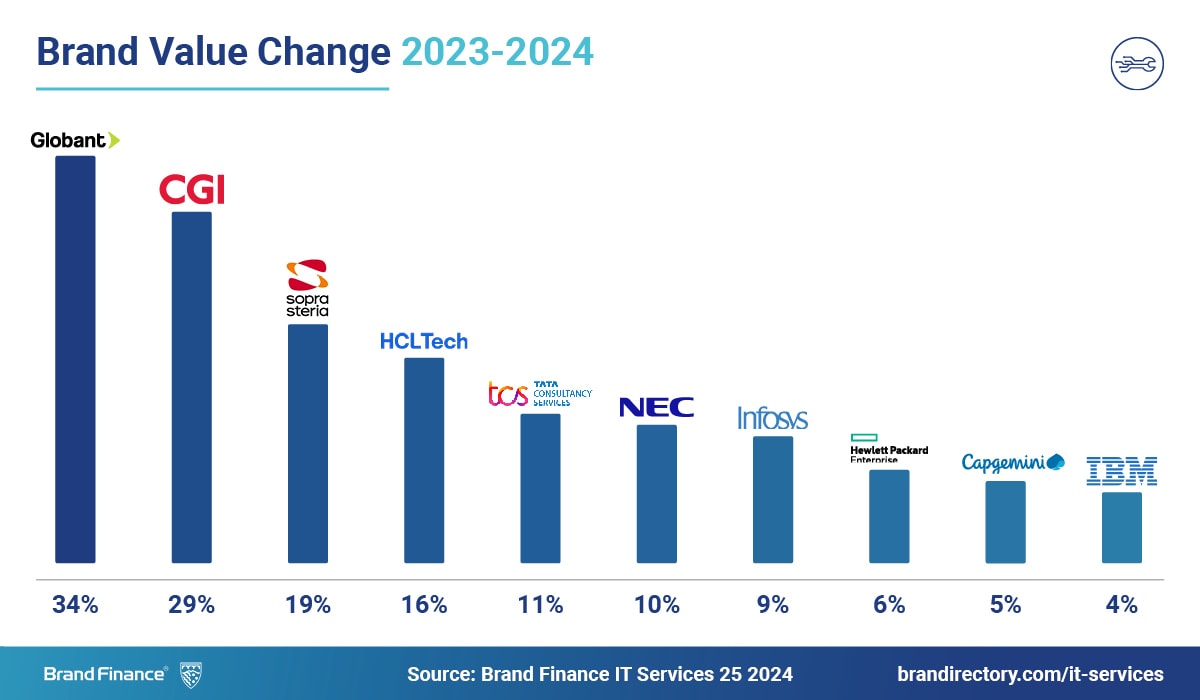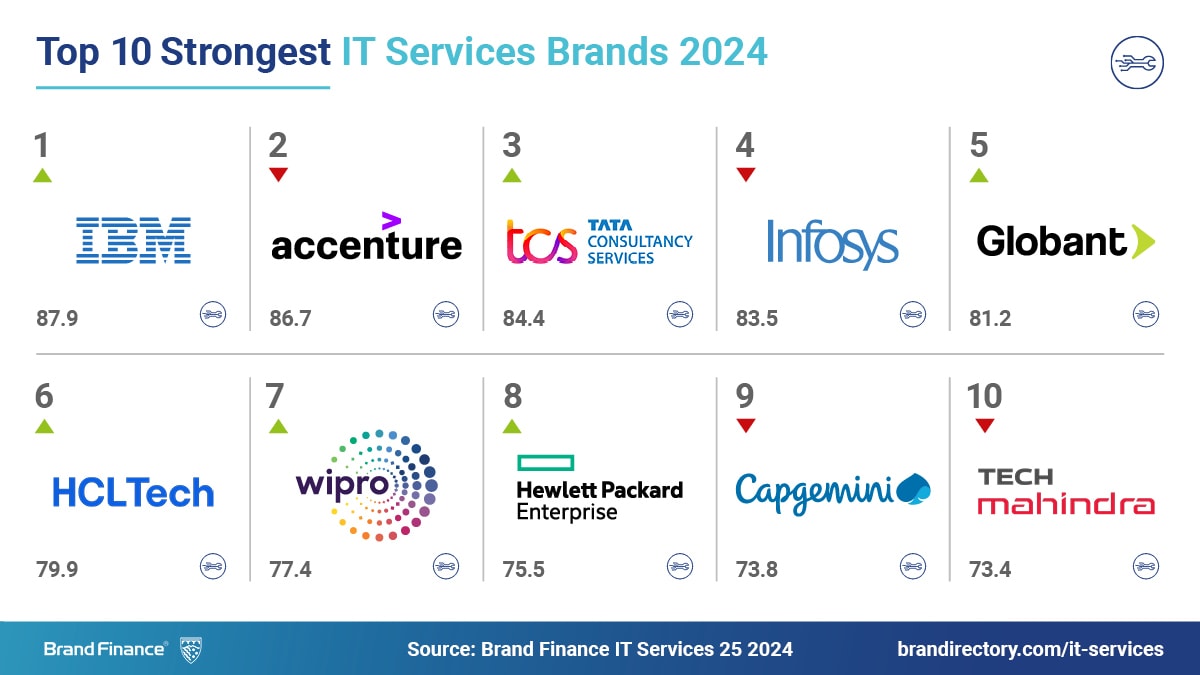View the full Brand Finance IT Services 25 2024 report here
Accenture (brand value up 2% to USD40.5 billion) and TCS (brand value up 11% to USD19.2 billion) continue to lead as the world’s most valuable IT services brands, according to a new report from Brand Finance, the world’s leading brand valuation consultancy. With generative large language models obtaining a lot of attention now, Brand Finance research suggests that Accenture is well poised to embrace the mega-trend that offers the possibility of reinventing businesses and industries.

TCS’s growth is driven in significant part by its continued and consistent brand and marketing investment. TCS's sponsorship of Formula E is a good example. The partnership with Jaguar not only gives TCS visibility with key audiences, building awareness and familiarity, but it also acts as a showcase for TCS’s capabilities, enhancing reputation and consideration.

Infosys has established itself as one of the preeminent IT services brands, achieving the fastest compound annual growth rate (CAGR) in brand value over the last five years among IT Services brands. With an impressive increase of 9.3% to USD14.2 billion this year, Infosys is now the third most valuable IT brand globally. Under the leadership of CEO Salil Parekh, who has recently ascended as the number 1 CEO in the IT services sector in the Brand Finance Brand Guardianship Index 2024, the company has consistently delivered strong brand value growth amidst rapidly evolving and challenging market conditions.
Lorenzo Coruzzi, Valuation Director at Brand Finance, said:
“While IT services brands thrived during the pandemic's digital transformation boom, a current slowdown driven by macroeconomic headwinds, inflation, and geopolitical tensions has them rethinking their strategies. Despite cautious short-term spending, the substantial long-term demand for AI presents a crucial opportunity for IT services brands to adapt and differentiate themselves.”
HCLTech’s brand valuation rise (brand value up 16% to USD7.6 billion) positions it among the five fastest-growing IT brands and as the fastest-growing brand among the top 10 largest IT brands in this year’s ranking, boosting value through significant sponsorship deals with sporting giants such as the New York Giants and New York Jets. According to Brand Finance’s research, HCLTech’s CEO was also top in the category of “is a sustainability champion” in the IT Services sector.
Globant (NYSE:GLOB), a company born in Argentina, has shown exceptionally fast growth in its brand value with a 34% growth to USD1.6 billion, making it the fastest growing IT Service brand in 2024.
Globant’s growth is driven by its growing global presence and strong financial performance, with Brand Finance research identifying a significant increase in consideration for the brand and other Brand Strength metrics: this year the Brand Strength improved from 77 to 81, making Globant a AAA- rated brand. Thanks to this increase, Globant secures a position amongst the top-5 strongest IT Services brands in the world.

Brand Finance is the world’s leading brand valuation consultancy. Bridging the gap between marketing and finance, Brand Finance evaluates the strength of brands and quantifies their financial value to help organisations make strategic decisions.
Headquartered in London, Brand Finance operates in over 25 countries. Every year, Brand Finance conducts more than 6,000 brand valuations, supported by original market research, and publishes over 100 reports which rank brands across all sectors and countries.
Brand Finance also operates the Global Brand Equity Monitor, conducting original market research annually on 6,000 brands, surveying more than 175,000 respondents across 41 countries and 31 industry sectors. By combining perceptual data from the Global Brand Equity Monitor with data from its valuation database — the largest brand value database in the world — Brand Finance equips ambitious brand leaders with the data, analytics, and the strategic guidance they need to enhance brand and business value.
In addition to calculating brand value, Brand Finance also determines the relative strength of brands through a balanced scorecard of metrics evaluating marketing investment, stakeholder equity, and business performance, compliant with ISO 20671.
Brand Finance is a regulated accountancy firm and a committed leader in the standardisation of the brand valuation industry. Brand Finance was the first to be certified by independent auditors as compliant with both ISO 10668 and ISO 20671 and has received the official endorsement of the Marketing Accountability Standards Board (MASB) in the United States.
Brand is defined as a marketing-related intangible asset including, but not limited to, names, terms, signs, symbols, logos, and designs, intended to identify goods, services, or entities, creating distinctive images and associations in the minds of stakeholders, thereby generating economic benefits.
Brand strength is the efficacy of a brand’s performance on intangible measures relative to its competitors. Brand Finance evaluates brand strength in a process compliant with ISO 20671, looking at Marketing Investment, Stakeholder Equity, and the impact of those on Business Performance. The data used is derived from Brand Finance’s proprietary market research programme and from publicly available sources.
Each brand is assigned a Brand Strength Index (BSI) score out of 100, which feeds into the brand value calculation. Based on the score, each brand is assigned a corresponding Brand Rating up to AAA+ in a format similar to a credit rating.
Brand Finance calculates the values of brands in its rankings using the Royalty Relief approach – a brand valuation method compliant with the industry standards set in ISO 10668. It involves estimating the likely future revenues that are attributable to a brand by calculating a royalty rate that would be charged for its use, to arrive at a ‘brand value’ understood as a net economic benefit that a brand owner would achieve by licensing the brand in the open market.
The steps in this process are as follows:
1 Calculate brand strength using a balanced scorecard of metrics assessing Marketing Investment, Stakeholder Equity, and Business Performance. Brand strength is expressed as a Brand Strength Index (BSI) score on a scale of 0 to 100.
2 Determine royalty range for each industry, reflecting the importance of brand to purchasing decisions. In luxury, the maximum percentage is high, while in extractive industry, where goods are often commoditised, it is lower. This is done by reviewing comparable licensing agreements sourced from Brand Finance’s extensive database.
3 Calculate royalty rate. The BSI score is applied to the royalty range to arrive at a royalty rate. For example, if the royalty range in a sector is 0-5% and a brand has a BSI score of 80 out of 100, then an appropriate royalty rate for the use of this brand in the given sector will be 4%.
4 Determine brand-specific revenues by estimating a proportion of parent company revenues attributable to a brand.
5 Determine forecast revenues using a function of historic revenues, equity analyst forecasts, and economic growth rates.
6 Apply the royalty rate to the forecast revenues to derive brand revenues.
7 Discount post-tax brand revenues to a net present value which equals the brand value.
Brand Finance has produced this study with an independent and unbiased analysis. The values derived and opinions presented in this study are based on publicly available information and certain assumptions that Brand Finance used where such data was deficient or unclear. Brand Finance accepts no responsibility and will not be liable in the event that the publicly available information relied upon is subsequently found to be inaccurate. The opinions and financial analysis expressed in the study are not to be construed as providing investment or business advice. Brand Finance does not intend the study to be relied upon for any reason and excludes all liability to any body, government, or organisation.
The data presented in this study form part of Brand Finance's proprietary database, are provided for the benefit of the media, and are not to be used in part or in full for any commercial or technical purpose without written permission from Brand Finance.